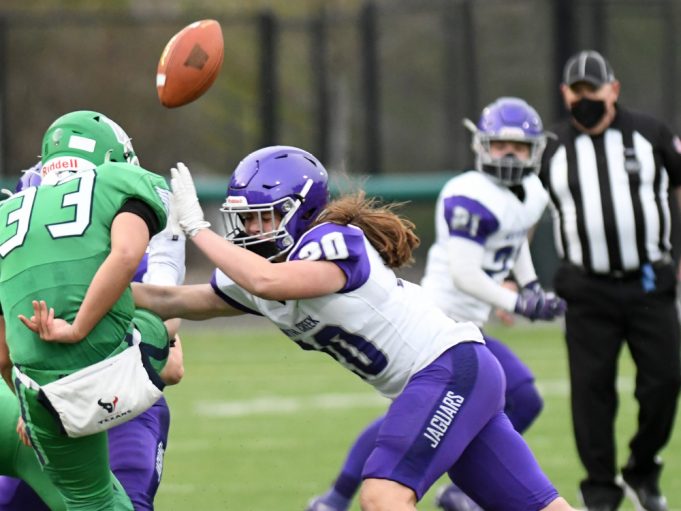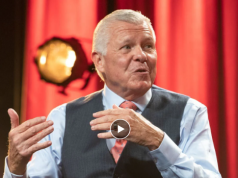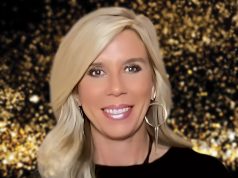Anyone who has ever attended a local association meeting knows rules debates can be intense.
“Discussions” over minutiae in the rulebook or casebook are often passionate, with the parties involved staunchly committed to their points of view.
Often, these exchanges conclude with the association president or some other officer saying, “This is what we got from the state office,” an interpretation from the state governing body.
But how are these interpretations made and who makes them? In some locales, interpreters are part of the state association staff. In others, they are outside parties, whether officially or in fact. In some instances, interpreters confine themselves to answering rules questions from coaches and officials, and conducting rules clinics. In others, however, they have assumed other responsibilities.
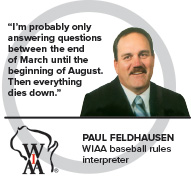 Paul Feldhausen has been the baseball interpreter for the Wisconsin Interscholastic Athletic Association for more than 35 years. For many years, one of his chief responsibilities was conducting rules meetings around the state; today, umpires and coaches in Wisconsin view a rules video instead.
Paul Feldhausen has been the baseball interpreter for the Wisconsin Interscholastic Athletic Association for more than 35 years. For many years, one of his chief responsibilities was conducting rules meetings around the state; today, umpires and coaches in Wisconsin view a rules video instead.
Virtually all of Feldhausen’s rules work takes place during the scholastic baseball season when he fields questions from coaches and umpires from around the state.
“I’m probably only answering questions between the end of March until the beginning of August,” he said. “Then everything dies down.”
Feldhauen also serves as the umpire-in-chief at the state tournament and is in his second tour of duty on the NFHS Baseball Rules Committee. His current term expires in 2022; he previously served from 1996-2000.
George Demetriou is one of the most influential figures in Colorado officiating circles. A longtime football and baseball official, he has served as an officer in the state football and baseball officials associations. (In Colorado, there are separate statewide officials associations for each sport.)
In 2009, Demetriou was appointed as the football rules interpreter for the Colorado High School Activities Association (CHSAA). He assumed the baseball interpreter’s post the following year and has held both jobs ever since.
On paper, Demetriou’s primary responsibility is assisting the CHSAA staff with responses to coaches with rules questions but through the years his role has expanded to the point where he spends only a fraction of his time in that role. “I actually do very little of that,” he said.
Today, Demetriou, who is also a rules columnist for Referee, functions as a liaison between the officials associations and the CHSAA office.
“I do a weekly bulletin during the season in both sports on rules issues that come up,” he said. “And sometimes, in both sports, I’m used as the investigating officer, if you will, for stuff that comes up.”
Demetriou is responsible for reviewing the game reports that referees are required to file following every varsity game. He’ll also interview officials in both sports who are involved in ejections and is involved in putting together the crews that work the state football playoffs.
He is also the author of a football mechanics manual that established standard operating procedures statewide.
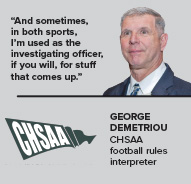 The CHSAA selects its state rules interpreters from the ranks of its state officials associations; the associations recommend candidates for the interpreter’s post but the CHSAA has the final say.
The CHSAA selects its state rules interpreters from the ranks of its state officials associations; the associations recommend candidates for the interpreter’s post but the CHSAA has the final say.
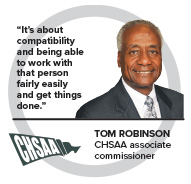 Tom Robinson, the CHSAA’s associate commissioner, oversees officiating matters. “We collaborate with that particular (officials association) sport and have them recommend who they think should be the rules interpreter,” he said, “and then we weigh in ‘Yea’ or ‘Nay,’ depending what our experience has been with that person.
Tom Robinson, the CHSAA’s associate commissioner, oversees officiating matters. “We collaborate with that particular (officials association) sport and have them recommend who they think should be the rules interpreter,” he said, “and then we weigh in ‘Yea’ or ‘Nay,’ depending what our experience has been with that person.
“It’s about compatibility and being able to work with that person fairly easily and get things done.”
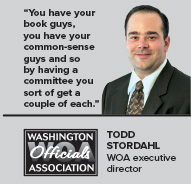 The state of Washington is unique in that the state governing body, the Washington Interscholastic Activities Association (WIAA) and the Washington Officials Association (WOA) are separate entities.
The state of Washington is unique in that the state governing body, the Washington Interscholastic Activities Association (WIAA) and the Washington Officials Association (WOA) are separate entities.
The two organizations collaborate, however, when it comes to rules interpretations.
Officially, the WIAA office issues all interpretations; each of four assistant executive directors is charged with overseeing specific sports. But Todd Stordahl, the WOA’s executive director, notes the officials have significant input into the process.
“That (assistant executive director) may or may not have experience with that sport,” he said. “So we set up a process where we have an eight-person committee for each sport and we use those individuals to help with those interpretations.”
Stordahl says the committees perform a variety of functions, depending on the circumstances.
“Sometimes we send (the rules question) to the committee and sort of get a feeling for what the committee thinks,” he said. “Other times, we’ll just go right to one person; usually there are one or two people on that committee we’ll go to if we need a quick answer and it doesn’t seem like it’s very controversial.
“If it’s something that could be controversial or something that isn’t going to go over real well, we send it to the entire committee to have them banter around with it. Hopefully they come up with a consensus. We share that information with the WIAA and they ultimately make the final decision on whether we go that way or not but most often whatever our committee says is what the interpretation is.”
Stordahl notes the committee system allows for the inclusion of a variety of viewpoints on rules issues.
“You have your book guys, you have your common-sense guys,” he said, “and so by having a committee you sort of get a couple of each.”
In California, most matters impacting interscholastic athletics are handled below the state level. The state is divided into 10 sections under the auspices of the California Interscholastic Federation (CIF), which serves 1,700 high schools.
The sectional model was created when the CIF was founded in 1914 to streamline the administration of high school sports in a state that spans approximately 163,700 square miles.
Rule interpretations, however, are handed down from the CIF office in Sacramento to each section, then disseminated from there to the rules interpreter of each local association — a total of 172 of them in 18 sports.
The state interpreter in each sport conducts a series of clinics throughout the state (done virtually this year) to pass along rule changes and interpretations.
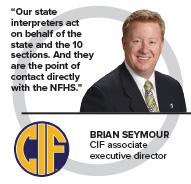 Brian Seymour, the associate executive director of the CIF, oversees officiating matters in the state. “In each of our sports we have a statewide rules interpreter,” he said. “This person is normally a former official for that particular sport or an administrator that has a background in that particular sport.
Brian Seymour, the associate executive director of the CIF, oversees officiating matters in the state. “In each of our sports we have a statewide rules interpreter,” he said. “This person is normally a former official for that particular sport or an administrator that has a background in that particular sport.
“Our state interpreters act on behalf of the state and the 10 sections. And they are the point of contact directly with the NFHS.”
The state interpreters also handle rules questions that are passed up the pyramid.
“That’s where the state rules interpreter really comes into play,” Seymour said, “because that’s a single voice on answering all types of questions when it comes to rules.”
When the CIF is in need of an interpreter, the search process is akin to searching for a new coach.
“We kind of put our athletic director hats back on,” Seymour said. “We have an ongoing list of people we like to communicate with once a position comes open. We have a list of people we’d be interested in talking to about it when the time comes.
“When that happens, we actually solicit resumes and we have people that will put in for the position. And we will interview and we will discuss it among our commissioners and our staff and then select the person we feel would do the best job statewide.’’
Kentucky keeps its rule-interpretation protocol almost entirely in house; interpretations are handled by the staff of the Kentucky High School Athletic Association (KHSAA). That’s not unusual. But the fact that Julian Tackett, the KHSAA’s commissioner, also serves as the state’s basketball interpreter is unique.
Tackett, who has been the commissioner going on 11 years and has worked for the KHSAA for nearly 37 years, had a long career in officiating. He worked NCAA Division I football and basketball in the Ohio Valley Conference and worked high school baseball.
At one time or another he’s served on the NFHS rules committees in all three sports; he just finished his fourth and final year of his term on the basketball rules committee.
“When I took the (commissioner’s) job, I had been the basketball interpreter three different times in 25 years,” Tackett recalls, “and the board just asked me to keep that duty.
“I was a longtime college referee so I knew the rules. They didn’t have a person in the office with a refereeing background.”
The KHSAA sponsors seven team and six individual sports. The seven senior members of the staff, including Tackett, serve as rules interpreters
“We do not utilize outside people,” Tackett said. “Outside people lead to mixed messages.
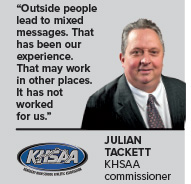 That has been our experience. That may work in other places. It has not worked for us. So, if we hire somebody that doesn’t have that expertise, we get them trained.”
That has been our experience. That may work in other places. It has not worked for us. So, if we hire somebody that doesn’t have that expertise, we get them trained.”
There are rare occasions when Tackett and his team will reach out for rules expertise.
“For wrestling, we issue the official interpretations,” Tackett said, “but we might lean on a key official in our state. But quite honestly, being here as long as I have, I feel like if I’m going to take the bullet for it, I might as well take the action for it.”
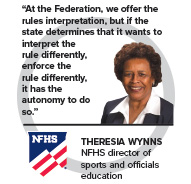 Theresia Wynns serves the NFHS as its director of sports and officials education. In that role, she sits on every NFHS rules committee as a non-voting member.
Theresia Wynns serves the NFHS as its director of sports and officials education. In that role, she sits on every NFHS rules committee as a non-voting member.
“We give a rules meeting every year for every sport that writes rules,” she said. “That should be the basis for rules interpretations. And we have a PowerPoint presentation the states have access to.”
Wynns explains the NFHS has a top-down approach to rules interpretations. “We interpret to our states,” she said. “Then it becomes the state’s responsibility to interpret to its constituents; the officials in that particular (state).”
Individual states have a fair amount of leeway when it comes to rules interpretations. “At the Federation, we offer the rules interpretation,” Wynns said, “but if the state determines that it wants to interpret the rule differently, enforce the rule differently, it has the autonomy to do so.’’
Concerns about regionalism — rules being interpreted differently in different states or in different regions of the same state — are hardly new.
People may read the language in the NFHS publications differently but more often, changes are resisted by members of the “old guard” in local associations who remonstrate, “We’ve always done it this way.”
Wynns says it’s important for state governing bodies to engage interpreters who are not only knowledgeable but respected within their sphere of influence and embrace NFHS interpretations and philosophies.
“Unless there is someone strong in the state that is interpreting to all of its constituents, that could muddy the waters, if they have interpreters who go rogue against what the state office is saying,” she said. “It makes a difference if you have a person with credibility, who knows the sport very well and who’s known throughout the state.”
Wynns notes that part of the interpreter’s role is to serve as an intermediary between the NFHS office and their state’s officials. “We don’t interpret to the masses,” she said.
Tackett says a major reason his state handles interpretations in house is to prevent local associations from “going rogue.”
“If we divest too much we end up with a lot of regionalism,” he said. “This (part of the state) does it this way, this part does it this way and that, in my personal opinion, is one of the absolute worst things you can have in officiating.”
What's Your Call? Leave a Comment:
Note: This article is archival in nature. Rules, interpretations, mechanics, philosophies and other information may or may not be correct for the current year.
This article is the copyright of ©Referee Enterprises, Inc., and may not be republished in whole or in part online, in print or in any capacity without expressed written permission from Referee. The article is made available for educational use by individuals.

